IN THIS ARTICLE
BIESZCZADY CENTRE FOR CULTURAL HERITAGE
Bieszczady Centre for Cultural Heritage
Industry:
Entertainment
Company website:
bcdk.pl
Location:
Ustrzyki Dolne, Poland
Wildlife, art, people, and, in addition, industry, or more precisely, issues related to oil extraction and its processing. How do we combine these four different topics in one exhibition space without neglecting any of them, without favouring and giving everyone the right amount of space? Especially an independent experience centre or museum could be created successfully for each issue.
The challenge of creating an immersive, multidimensional multimedia space in which the creators of the Immersive Room at the Bieszczady Centre for Cultural Heritage in Ustrzyki Dolne can learn in an attractive form. Of course, multimedia can help you tell diverse stories.
Often, in the exhibitions currently being created, we encounter more and more complex and spectacular installations. We can undoubtedly say such an installation as the one in Ustrzyki Dolne is nowhere in Poland. The show’s friendly yet complex content was created. Everything has been included in one readable whole, and although there are many threads, the course of the action is smooth and easy to perceive. Giant LED screens, eighteen powerful laser projectors, multi-channel immersive sound and an extensive management and control system. The effect? Breathtaking!
We invite you on an extraordinary journey into the heart of the Bieszczady Mountains!
HISTORY
The Fanto refinery was established in 1887 during the so-called “Bieszczady Black Gold Fever.” Oil was extracted and processed in the region.
Consistent development transformed a small oil distillation plant at the end of the 19th century into a huge international company. In the 1920s, its processing capacity was 54 thousand tons, and 450 employees worked there. The refinery also built huge reservoirs near the railway line, which served as oil warehouses.
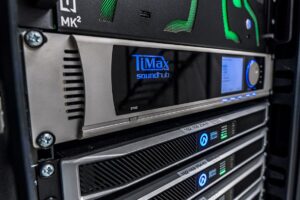
The economic crisis of the 20th century and changes in the fuel market reduced the demand for this raw material. The Fanto Refinery was liquidated, and the wood industry began to develop. In the 1960s, a wood products factory, Pilak, was built here. It became the property of the State Treasury and then the State Forests. The main building after the Refinery became the property of the Bieszczady district.
Unfortunately, when the company left this space, the condition of the facility began to deteriorate strongly. A few years ago, it was decided that in the abandoned, devastated halls, where the only well-preserved element was the wooden structure of the roof, the Bieszczady Cultural Heritage Centre would be established. The revitalization of the entire space, modernization of the interior and activities aimed at restoring the fantastic facade of the complex were undertaken.
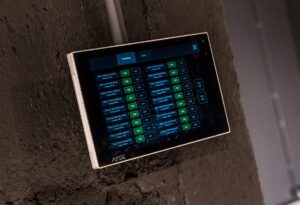
MODERNIZATION
After several years of work, a spectacular multimedia room, three exhibition zones and a concert hall were created here.
The entire investment cost PLN 50 million, of which 90 per cent was financed through grants from the European Economic Area countries Iceland, Liechtenstein, and Norway, as well as from the Ministry of Culture and National Heritage’s budget.
Group AV developed the project, delivered all systems, assembled them, integrated them, and comprehensively commissioned the immersion room. In total, the project took about four months to implement, and the installation of the devices and their commissioning took less than a month, a record.
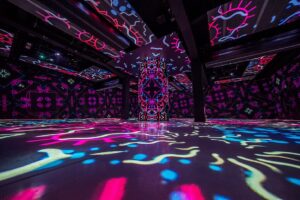
After selecting the appropriate multimedia systems to fill the space with an area of almost 250 square meters, the team proceeded to develop the scenario of the multimedia performance. Tomasz Zalewski, Technical Director of Group AV, recalls this process: “The main challenge in this phase of implementation was to develop an interesting scenario and implement an engaging narrative. The idea was to show the history of several planes, presenting four main themes: People, industry, art and nature.
In the projection, we also had to expose some exciting historical themes that perhaps many people do not know. One example is that in its time, the Bieszczady Mountains were one of the most populated areas in Poland! There were also a very large number of factories in this area. The assumption was also the show’s duration, just over 15 minutes. With this knowledge, we started to create scripts, recordings, graphic designs, and post-production. We made recordings in the field, used available materials, and created animations from scratch. What is essential is that in an immersive space, we do not tell stories directly. Still, we play on guesses, we influence our senses, we impressively tell stories, we refer to the imagination of the viewers.”

MULTIMEDIA SHOW
Marek Andruch, the starost of Bieszczadzki, also played a vital role in developing the concept of the museum and the subsequent creation and implementation of the entire project. From the beginning, he tried to make the available space a typical museum, set the direction and paid great attention to aspects such as people, art, economy, industry and nature, which were very important in the Bieszczady region then. On the other hand, selecting appropriate hardware solutions and preparing the ready-made scenario was entrusted to Group AV as part of the tender procedure.
The huge immersion space in the heart of the former Fanto Refinery is not only “immersive” by name but also unique in Poland and Europe. Different image and sound technologies were combined, surrounding guests from all sides and fully immersing them in the story.
The integrator has chosen a projection to display on the floor and walls. LED screens that make up the ceiling and cylindrical LED screens located in the centre of the room and still not often seen steam screens in combination with adequately prepared content give the impression of three-dimensionality of the presented image or effect similar to a hologram.
Fourteen Panasonic PT-MZ14K projectors were used to display the image on the walls and the floor. Two projectors support each wall, four additional projectors display the image on fog screens, and six more machines shine on the floor. These are very quiet projectors with a brightness of 14,000 lumens and WUXGA resolution. All projectors are equipped with ultra-short-throw lenses to display a large image from a relatively short distance.
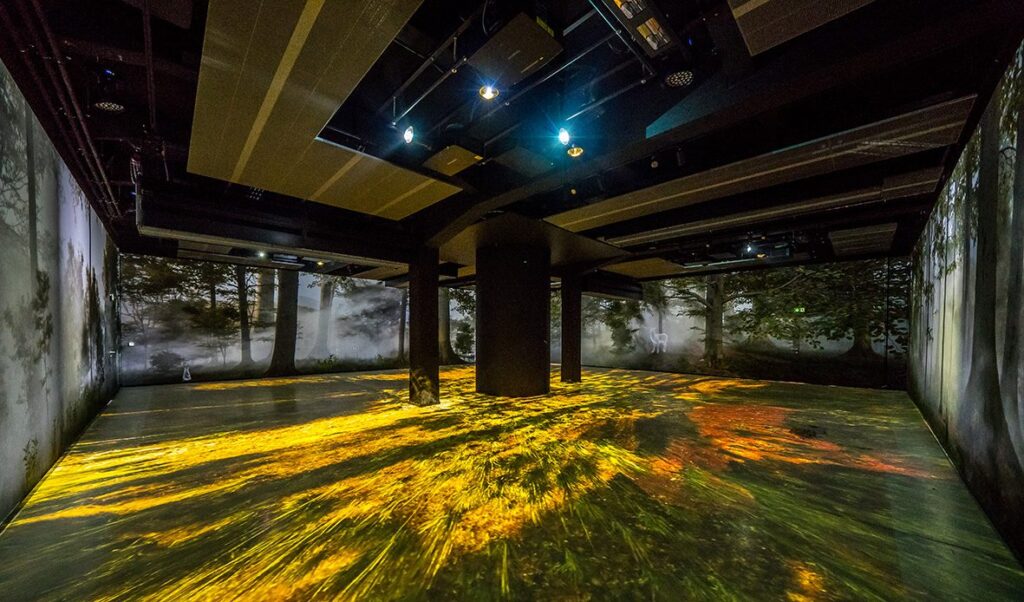
The lens shift function, which has a wide range and is available in the projectors used, was also crucial in this particular system, enabling precise correction of the displayed image. Tomasz Zalewski, Technical Director of Group AV, points out: “In ultra-short-focal projectors, we have a minimal zoom, almost zero, so providing the possibility of geometric adjustment of the projectors front-to-back, and in the case of devices projecting onto the floor, they were of great importance”.
LED screens in several variants were installed on a specially prepared structure under the ceiling. A square screen with modules with a resolution of P2 was placed in the middle. The rest of the space was filled with a transparent screen with an asymmetrical resolution of 3.8 x 7.6 mm.
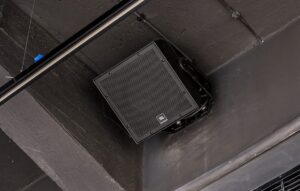
DISPLAYS
The list of image display devices installed in this room is closed by a centrally installed cylindrical screen with a diameter of 2 meters, for which the fully flexible P1.87 mm modules were used. The entire spatial structure on which the LED modules rest was made directly in the manufacturer’s factory and is attached to both the floor and the ceiling.
It should not be surprising that, according to accepted global standards, all LED screens are processed using Novastar devices. Due to the high resolutions of individual displays, the integrator had to use three advanced VX16s processors from this manufacturer.
To ensure the highest level of safety, Group AV decided to equip all LED modules constituting each of the screens installed on the ceiling with steel cables, giving the installation complete safety. These cables are attached to the cabinets and rigidly attached to the steel structure installed under the ceiling.

ENCODING
All media are fully synchronized and combined into one coherent system, allowing you to play a multimedia audio-video spectacle. To make this possible, two media servers of Green Hippo Boreal+MKII were installed in the server room behind the immersion space’s wall.
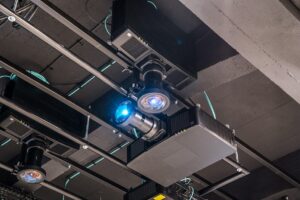
Each device sends four 4K signals via the AMX N2600 encoders to the set-top boxes located at the projectors, in which, thanks to the possibility of selecting only a part of the image for display, the image is split. This allows independent signals to be fed from one physical media output of the server to four projectors. This reduced the number of cards and server media throughout the installation and eliminated the need for additional video splitters. The signals between the encoders in the server room and the decoders installed at each projector are transmitted over the IP network using the AMX protocol. Further, after decoding, the signal is transmitted using standard, short HDMI cables.
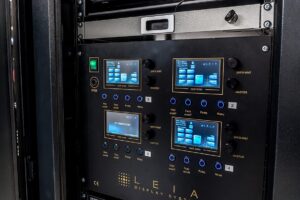
Interestingly, no additional software was used to configure the entire projection. Still, all work was carried out at the media server level, which controls the playback of video content and an external timecode generator or even infrared radiators. This confirms that the solutions with the green hippopotamus logo are very versatile devices that enable pre-production, configuration of the entire system, launch, and later daily content playback as part of the installation’s operation.
At the beginning of the design process for the entire installation, a 3D model of space was created, and individual content elements were placed in it. This significantly facilitated and accelerated the work, allowed tracking of the effects, and allowed for ongoing changes.

The AMX NX-1200 control processor manages the entire system. Interestingly, performances are not run on schedule but on request. When the correct number of guests are gathered to see the show, the AMX VARIA SL-80 can start the show immediately with just one button.
The system is pervasive, and parts of the video, audio, and DMX protocols are involved. Therefore, it is connected based on timecode. An external generator triggers individual events.
Fog screens, innovative luminaires, and heat radiators complement the LED screens and projectors. During several moments throughout the performance (e.g., a fire or explosion), the fire visible on the screen is enriched with the heat generated by the radiators, giving the viewers an even more suggestive impression. All three groups of devices mentioned now are controlled from the grandMA2 console.
As the integrator points out, a real challenge was creating a structure under the ceiling on which all devices were installed, using unique mounting solutions and fastening systems. The installation of projectors has already brought many challenges. They are installed vertically and horizontally and must pass and shine on the walls and floor. They were installed on trusses equipped with a unique system for moving machines to the right and left, up and down, back and front.
Another challenge was that projectors with so much power generated a lot of heat. And it should be added that even five such powerful machines are in the hall’s corners! Therefore, the integrator had to think very carefully about the location of the projectors so that blowing air did not affect their overheating and thus prevented them from automatically switching off.

SOUND
There is no immersion without sound.
It is hard to imagine an engaging multimedia message without accompanying sound. The integrator opted for the immersive Outboard TiMax sound system, which includes thirty-two JBL Professional SCS8 speakers installed on the ceiling and in areas where walls and ceilings meet. Powered by digital, advanced LEA Connect 354D amplifiers, these speakers enable cloud-based management, control, and monitoring from anywhere in the world.
In addition, two JBL Professional AC115S subwoofers are installed in this space. These subwoofers raise and amplify the effects of blows or explosions. The woofers are powered by the Crown XTi 2002 power amplifiers assigned to them.
Since the whole room has a relatively large area of over 250 square meters and there are empty walls and concrete floor generating reflections, the sound system used needed to allow for a complete, flexible configuration. The Integrator wanted the system to have a sufficiently large number of tracks so that the listeners could feel in an immersive, suggestive way individual events happening on the screens, as well as flexible directing of the entire sound layer of the show. Tomasz Zalewski from Group AV says, “When working with the Outboard TiMax system, we do not have to modify the whole show, but we can flexibly play and place individual events at the right points on the timeline. Once we had the script ready and knew what we would show during the performance, we started putting objects in space, and for some, we introduced movement.”
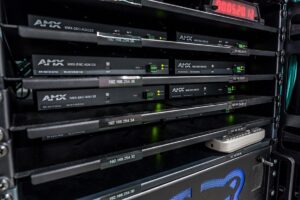
During the several-minute show, not only does the lector’s voice appear, but there is also a massive variety of sounds and sound effects. Some were recorded in the studio, and some were purchased from bases. However, most of them were recorded specifically for the needs of this installation. This effect layer consists of sounds of nature, animal sounds, sounds of a working factory, voices of speakers speaking in many different languages, which refers to the multicultural character of the region, and even fragments of folk music, both those for which licenses were obtained and those recorded in the sound studio.
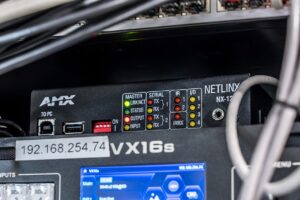
One of the privileges and great advantages of our work is that every month we have the pleasure of visiting many fantastic facilities and observing unique installations. And when we think we have seen it all and think we know exactly what effect will be achieved with a given solution, then something that we have not yet seen, something that is breathtaking and stays with us for a long time.
Such an example is the immersion space described here in the Bieszczady Centre for Cultural Heritage in Ustrzyki Dolne. Group AV has created a project that allows you to immerse yourself in the content it talks about.
The appropriate projectors selected for this installation proved that projection still has considerable power. The projected image is exceptionally plastic, multidimensional, and almost painterly. Moreover, the projection image was skillfully combined with LED screens, both transparent and cylindrical central screens, which further expanded the “virtual canvas” and gave the whole space a unique character.
Of course, we can no longer talk about a multidimensional multimedia spectacle and digital space without the right sound today. The Integrator has taken particular care of this aspect. The immersion hall in the Bieszczady Cultural Heritage Centre in Ustrzyki Dolne has been implemented a multi-channel, immersive TiMax sound system, which works perfectly, creating spatial, engaging sound scenes and imitating effects known from nature and the world around us.
We should not forget the extensive control, management, and signal transmission system and the two media servers, Green Hippo Boreal+ MKII, which play content. Without these, the exhibition could not have been launched. Remember that a media server is a video clip player and an extensive tool. It contains a 3D map of the entire room, and the content is adjusted to the physical properties of the space here.
The media server Green Hippo calculates the position of each projector relative to the walls or floor to correctly display the image on the deformed plane, or the pixels are converted to make the image display correctly on LEDs with different pixels. Using the rating system of the famous culinary guide, it is not a space that can be visited by the way or while passing through Ustrzyki; it is a place worth visiting, especially from a distance! It is mandatory!
Text and photos: Lukasz Kornafel, “AVIntegracje” | link to original Polish text

